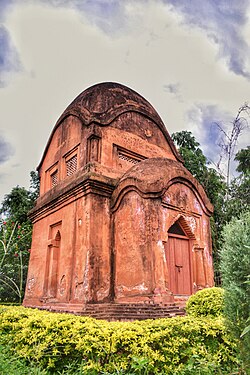Medieval Kangleipak
Medieval Kangleipak or Medieval Manipur is the long period in the history of Manipur between the "ancient period" and the "modern period".[1] It encompasses the 15th century AD to the 19th century AD.[2]
Periods[edit]
Early medieval period[edit]
The medieval period of Manipur starts with the slow declining of the indigenous Meitei faith during the reign of King Senbi Kiyamba. In celebration for their victory over Kyang, the King of Pong presented Kiyamba with a golden box containing a stone known as Pheiya (Almighty).[3] Kiyamba built a brick temple in the capital Lamangdong, 27 kilometres (17 miles) south of Imphal, in 1475 for the sacred stone. During this period, Bramins migrated to Manipur.[4] Legend states that a Brahmin identified Pheiya as Vishnu and said that good fortune would come to the king and kingdom if rice boiled in cow's milk was offered to the deity.[5] Lamangdong was subsequently named Bishnupur (Abode of Vishnu) in honour of the temple. Simultaneously, the little by little immigration of the Brahmins from the Bengal starts the onset of Hinduism in the kingdom.[6][7]
Late medieval period[edit]
During the late medieval period, it was during the reign of Emperor Pamheiba that Hinduism became the state official religion in the kingdom, with the replacement of the indigenous Sanamahism in the 18th century AD.[8][9][10][11] Simultaneously, in 1729 AD, the Puya Mei Thaba, the burning up of the sacred scriptures took place in the Kangla by the order of the then monarch, Pamheiba.[12]
Manipur Kingdom was annexed by the Burmese forces after which Bhagya Chandra (Ching-Thang Khomba), the grandson of Pamheiba, appealed to Ahom king Rajeswar Singha for military assistance. Rajeswar Singha agreed to send an army to overthrow Chitsai and reinstate Bhagya Chandra. The expedition hit many snags in Nagaland where they were attacked by Naga tribesmen and poisonous snakes. Rajeswar Singha called off the unsuccessful venture in 1767. In November 1768, Bhagya Chandra and Rajeswar Singha decided to make another attempt to invade Manipur. This time Bhagya Chandra led 10,000 Ahom troops across the Kachari kingdom to the Mirap river. Many battles ensued between the Ahoms and Meiteis on one side, and the Naga, Chitsai and the Burmese on the other. In 1773, Bhagya Chandra was reinstated as Ningthou of Manipur[13]
The tradition of Rasa Lila in Manipur Kingdom is attributed to Ching-Thang Khomba. The first Manipur Maha Rasleela was performed in 1777.[14]
It was his daughter Shija Lailoibi, who first took the role of Radha in the Manipuri dance. Under the influence of Bengali missionaries, he also started the tradition of Sankirtan in Manipur.[15]
Gallery[edit]
- Govindajee temple.jpg
Sources[edit]
- http://e-pao.net/epSubPageExtractor.asp?src=manipur.History_of_Manipur.History_Of_Medieval_Manipur_1
- http://e-pao.net/epSubPageExtractor.asp?src=manipur.History_of_Manipur.History_Of_Medieval_Manipur_2
- http://e-pao.net/epSubPageExtractor.asp?src=manipur.History_of_Manipur.History_Of_Medieval_Manipur_3
- http://e-pao.net/epSubPageExtractor.asp?src=manipur.Ethnic_Races_Manipur.Origin_of_the_Meiteis_3
Further reading[edit]
- https://www.imphaltimes.com/it-articles/item/15075-hinduism-in-manipur
- https://www.jstor.org/stable/44156597?seq=1
- https://www.jstor.org/stable/44145476?seq=1
References[edit]
- ↑ http://e-pao.net/epSubPageExtractor.asp?src=manipur.History_of_Manipur.History_Of_Medieval_Manipur_1
- ↑ https://themanipurpage.tripod.com/history/puwarimeitei.html#(iii)%20The%20Medieval%20Period
- ↑ Keerti Chand Tensuba (1993). Genesis of Indian Tribes: An Approach to the History of Meiteis and Thais. New Delhi: Inter-India Publications. ISBN 9788121003087.
- ↑ Takhellambam Debachand Singh (April 2014). "Phonological System of Medieval Manipuri". Language in India. 14 (4): 58.
- ↑ P. Lalit. "A Brief History (Puwari) of the Meiteis of Manipur". The Resource Centre for Indian Language Technology Solutions.
- ↑ https://themanipurpage.tripod.com/history/puwarimeitei.html#(iii)%20The%20Medieval%20Period
- ↑ http://e-pao.net/epSubPageExtractor.asp?src=manipur.Manipur_and_Religion.Hinduism_in_Manipur_Part_1_By_Chirom_Rajketan
- ↑ http://e-pao.net/epSubPageExtractor.asp?src=reviews.arts.Hinduism_in_Manipur_A_Political_Perspectives_By_Rinku_Khumukcham
- ↑ http://e-pao.net/epSubPageExtractor.asp?src=manipur.Manipur_and_Religion.Hinduism_in_Manipur_Part_1_By_Chirom_Rajketan
- ↑ http://e-pao.net/epSubPageExtractor.asp?src=manipur.Manipur_and_Religion.Hinduism_in_Manipur_Part_2_By_Chirom_Rajketan
- ↑ http://e-pao.net/epSubPageExtractor.asp?src=manipur.Manipur_and_Religion.Hinduism_in_Manipur_Part_1_By_Chirom_Rajketan
- ↑ http://e-pao.net/epSubPageExtractor.asp?src=news_section.opinions.Puya_Meithaba_The_Burning_of_Meitei_Sacred_Scripture_By_Madhu_Chandra
- ↑ C. E. A. W. O. (1927). "A History of Assam by Edward Gait". The Geographical Journal. 69 (3): 271. doi:10.2307/1782048. JSTOR 1782048.
- ↑ "Manipuri Dance: Both Ritualistic and Recreational". Archived from the original on 17 March 2014. Retrieved 11 November 2016.
- ↑ "Information - Snippets - narthaki.com". Archived from the original on 11 October 2008. Retrieved 11 November 2016.







